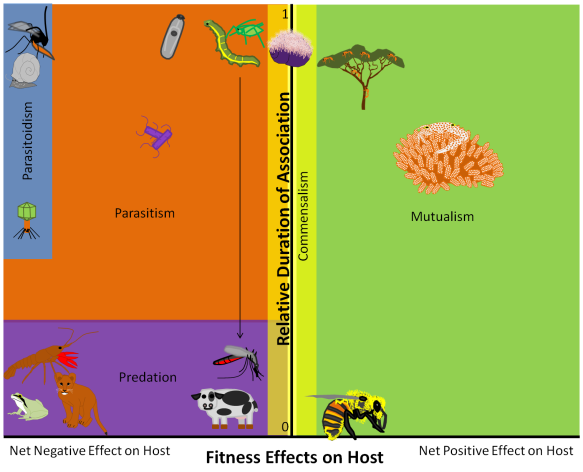One of the most frequently accessed posts on this blog defines the terms “predator,” “micropredator,” “parasite,” and “parasitoid” and then presents a classification scheme for differentiating among those natural enemies (Lafferty and Kuris 2002). If you haven’t read that post yet, I recommend taking a look before you read this one. I obviously fancy the dichotomous key presented in the previous post quite a bit. However, it is not be the best classification scheme for all situations. For example:
- Check out Britt Koskella’s comments on the previous post – it is difficult to classify the bacteriophages that she studies using that classification scheme.
- The previous key may be difficult to use for educational purposes. For instance, it requires explaining castration and trophic transmission, which are concepts that might be unnecessarily complicated for explaining the distinction between parasites and predators to non-specialists.
- The previous key only deals with natural enemies, so we can’t use it to explain how mutualists and commensalists fit into this group of trophic relationships.
- The previous key doesn’t show how relationships can vary with life stages, ecological conditions, and environmental conditions.
- The previous key doesn’t have any pictures of snails on it. (Priorities.)
Therefore, having an additional classification scheme that specializes in some of the aforementioned areas would be useful. And – you guessed it – one was recently(ish) published (Parmentier and Michel 2013)! This classification scheme uses two continuous variables to designate relationships: the relative duration of the association (RDA) and the fitness effects on the ‘host.’
The relative duration of association ranges from 0 to 1, where 0 means that the ‘symbiont’ (including predators) spends none of its lifetime associated with the ‘host’ (or prey), and 1 means that the symbiont spends all of its lifetime associated with the host. For instance, predators and micropredators have RDA’s close to zero – a lion spends only a small portion of its life with a single zebra prey. Conversely, an adult trematode parasite (the worm in the orange section of the figure) will spend that entire life stage in association with a single host. The RDA is the Y axis on the figure below.
In recent months, we’ve talked a lot about the fitness effects that symbionts have on their hosts. Briefly, symbionts may have both negative and positive effects on hosts, and it is the net effect that determines how we classify the relationship. However, the net effect can vary with ecological and environmental conditions (see here, here, and here). Therefore, whenever we place a point on this graph, we need to remember that it might slide left or right as conditions vary.
Parasitoid wasps spend the entirety of their larval life stage in the host, and they ultimately kill the host. In this figure, parasitic castrators – like the trematodes that castrate snails – end up in the same region as the parasitoids. And this is where bacteriophages and Cordyceps fungi would fall out, too. However, like we discuss in the previous post, the term “parasitoid” is probably not a good one for this group, because that term is usually used to refer specifically to the unique life cycles of parasitoid wasps. In this figure, it means any parasite that reduces host fitness to zero.
Predators like lions, frogs, and crayfish also reduce prey fitness to zero. However, micropredators and herbivores (e.g., mosquitoes and cows) are special classes of predators that do not kill their prey. Then there is a group of animals that consume plants, but are probably more appropriately classified as parasites because they spend the majority of their life span (or a single life stage) on a single host plant. Therefore, things that eat plants will typically fall out somewhere between the aphids and the micropredators. (I should note that herbivores can have more than minimal impacts on host plant fitness, but many grazers have small impacts.) Similarly, Mark Siddall – the man who went on a quest for the hippo ass leech – doesn’t like classifying leeches as micropredators, because some spend most of their time on a single host. Therefore, most leeches would also fall out somewhere along that line between aphids and mosquitoes. Except, yaknow, the ones that are actually predators, and fall out near the lions.
On the mutualism side of things, we have symbionts like pollinators, which are only very briefly associated with each host; they’re like micropredators, but with positive fitness effects on their hosts. And then there are symbionts that are associated with single hosts for most of their lifespans, like ants on Acacia trees or guard crabs on corals. But again, remember that those relationships might shift left on the X axis as conditions vary.
Speaking of which, finding an example of a commensalist is hard. I used the example of epibionts on hermit crab shells, which help protect the hermit crabs from some predators but make the hermit crabs more susceptible to other predators. The net effect is unclear, but the positive and negative effects might balance out to a zero net effect.
So, there you have it. I think this figure should be really useful, especially as a general framework.
References:
Lafferty, K.D., and A.M. Kuris. 2002. Trophic strategies, animal diversity and body size. TREE 17(11): 507-513. (Direct link to PDF download)
Parmentier, E., and L. Michel. 2013. Boundary lines in symbiosis forms. Symbiosis 60: 1-5.


Very nice post! By the way, if you understand Portuguese, I recommend this video: https://youtu.be/vaeYOzVCMZg.
Thanks! I wish I understood Portuguese, because I would definitely enjoy that. I watched it anyway. 😛 Have you seen my post about the MUTOs in Godzilla? https://parasiteecology.wordpress.com/2014/06/16/godzilla-parasites/
You’re welcome! No, I didn’t. I’m gonna check it out.
Pingback: One Model to Rule Them All? | Parasite Ecology
Pingback: Mutualism vs. Symbiosis | Parasite Ecology